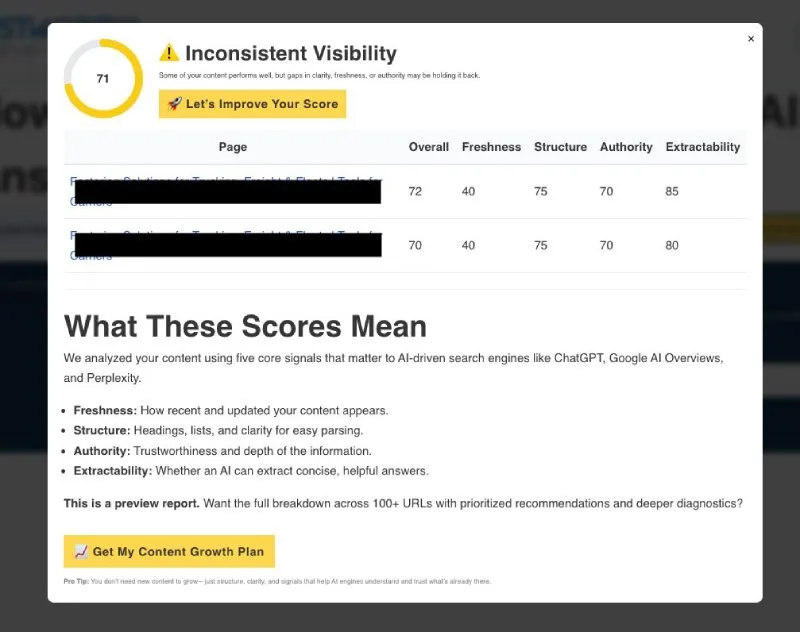You could have the best content in your industry, but if ChatGPT, Gemini, or Perplexity can’t see it, you’re invisible to millions of high-intent users who are shifting away from Google. At Trustworthy Digital, we’ve watched this shift accelerate rapidly over the past year, and it’s becoming impossible to ignore. The smart move is to discover your AI visibility score and do something about it now, before your competitors get ahead. In the meantime, here are the most effective strategies for AI visibility enhancement.
Strategies You’ll Learn:
- Create Topical Depth and Clarity
- Structure for AI Readability
- Add Authority Signals
- Improve Crawl & Accessibility
- Keep Content Fresh and Updated
- Optimize for Prompt Compatibility
- Use Structured Data (Schema Markup)
- Leverage Multimedia Elements
- Build Brand Mentions Across the Web
- Track, Test, and Iterate

1. Create Topical Depth and Clarity
Write content that fully answers a topic, not just checks a box. AI-powered search engines love content that’s easy to read and extract from. When you create in-depth content, you increase your chances of being cited as a primary source rather than getting overlooked by competitors who provide more complete answers.
Here’s how to build content depth:
- Answer the main question completely – Don’t leave readers hanging with partial information that makes them search elsewhere for answers
- Add context, subtopics, and FAQs – Cover all the angles people care about, including background information and related concepts they might not know
- Include expert insight – Share what you actually know from experience, not just what you read online or learned from competitors
- Go beyond bullet lists – Provide real explanations with examples, case studies, and detailed reasoning behind your recommendations and advice
- Think like your customer – What would they ask next after reading your answer, and how can you anticipate those questions?
2. Structure for AI Readability
Use logical headings (H2s/H3s), bullet lists, FAQ blocks, and short self-contained paragraphs for effective AI search optimization. AI systems scan for clear information hierarchy. Your content needs to be digestible not just for human readers, but for the algorithms that determine whether you get cited.
Make your content AI-friendly:
- Use descriptive headings – Tell readers exactly what each section covers instead of vague titles that don’t communicate the actual value inside
- Break up long paragraphs – Keep them under 4 sentences when possible so AI systems can easily extract specific information without confusion
- Add FAQ sections – AI loves pulling from these structured question-and-answer formats because they match how people actually search for information
- Include bullet lists – They’re easy for AI to extract and present to users in a clean, scannable format that answers questions quickly
- Implement schema markup – FAQPage schema helps structure content for extraction by providing clear signals about what information is most important
3. Add Authority Signals
AI platforms prefer content with credentials, quotes, references, and citations. Showcase experience, expertise, authority, and trust through author bios, external references, and industry recognition. Content marketing drives measurable results, but only when it demonstrates genuine authority. Without these trust signals, even excellent content gets overlooked by search engines that prioritize credible sources.
Here are the key authority signals to include:
- Author credentials and bios – Display your qualifications, experience, and expertise prominently so AI platforms understand you’re a credible source of information
- Link to reputable sources – Reference authoritative websites, studies, and publications that support your claims and provide additional context for readers
- Include real data and case studies – Share specific examples, statistics, and results from your actual work rather than generic industry claims
- Add client testimonials and reviews – Social proof helps AI systems understand that real people trust and value your expertise and recommendations
- Reference industry recognition – Mention awards, certifications, speaking engagements, or media coverage that validates your authority in the field
Authority isn’t just about what you say; it’s about proving you know what you’re talking about. These platforms are getting better at spotting thin content that lacks substance, so focus on building genuine credibility through real expertise and verifiable accomplishments.
4. Improve Crawl & Accessibility
Ensure GPTBot and other AI crawlers can access your content. Avoid JavaScript-heavy rendering, broken robots.txt files, or blocked meta headers that prevent AI models from reading your pages. Technical barriers are citation killers. Your content might be brilliant, but if AI crawlers can’t access it, you’re fighting an uphill battle for visibility in generative responses.
The basics matter more than you think. Fast loading times, clean code, and proper technical setup aren’t glamorous, but they’re essential for AI content discovery. If crawlers can’t read your page, you’re invisible no matter how good your content is.

5. Keep Content Fresh and Updated
AI platforms love fresh content. Regular updates increase your chances of visibility in newer AI training snapshots. Stale content, regardless of quality, gets pushed aside by AI models that favor current information. Set up a content refresh schedule to maintain a competitive advantage in AI visibility rankings and keep your expertise current.
This doesn’t mean rewriting everything from scratch. Update statistics, add new examples, refresh outdated information, and expand sections that could use more detail. Even small updates signal to these platforms that your content is current and relevant.
6. Optimize for Prompt Compatibility
Write in the format of real human questions and include answers to sub-questions AI might extract in conversations. Think about how people actually ask questions to AI assistants. Your content should anticipate follow-up questions and provide complete answers that AI systems can easily extract and present.
Smart prompt optimization tactics:
- Write like people talk – Use natural language, not corporate speak, because that’s how people actually ask questions to AI assistants
- Answer obvious follow-up questions – What would someone ask next after getting your initial answer, and can you provide that information too?
- Include conversational phrases – “Here’s what that means” or “The key thing to know is” help AI systems understand context and importance
- Structure answers clearly – Make it easy for AI to find and extract your points by using consistent formatting and logical flow
- Test your content – Ask AI assistants questions about your topic and see what they pull to understand how well your content performs
This approach works really well for getting cited in AI responses and overall generative AI visibility.
7. Use Structured Data (Schema Markup)
Implement FAQPage, HowTo, QAPage, Table, or Product schemas to help AI parse your content for structure and meaning. Schema markup acts as a roadmap for AI platforms, making your content more extractable and citation-worthy. Without proper structured data, you’re relying on these platforms to guess what your content means rather than clearly communicating its value and relevance.
Key schema types for AI visibility:
- FAQPage schema – Perfect for question-and-answer content that directly matches how people search and how AI platforms prefer to extract information
- HowTo schema – Great for step-by-step guides and tutorials that break down complex processes into manageable, actionable steps for readers
- Article schema – Helps AI understand your content type and topic while providing context about authorship, publication date, and main subject matter
- Table schema – Makes data and comparisons easy to extract by clearly defining relationships between different pieces of information you’re presenting
- Local Business schema – Essential if you serve local markets because it helps AI systems understand your geographic relevance and service areas
8. Leverage Multimedia Elements
Use charts, infographics, image captions, and descriptive alt text. AI is increasingly multimodal, supporting citations with visual context alongside text. Well-optimized images and graphics provide additional citation opportunities and help your content stand out in AI content discovery systems. Visual elements also improve user engagement when people do visit your pages directly.
Don’t just add images for decoration. Use visuals that actually support your content, add descriptive alt text that includes relevant keywords, and make sure your images load fast. Charts and infographics are particularly valuable because they present information in ways that AI systems can understand and reference.
9. Build Brand Mentions Across the Web
Get cited on press sites, guest blogs, Reddit, Quora, and other AI-scraped platforms. Mentions in reputable sources increase your chances of being cited in AI responses. SEO investment still matters for brand visibility, and brand mentions work similarly for AI visibility. The more places your brand appears with authority, the more likely AI systems will recognize and cite you.
Focus on quality over quantity:
- Target reputable publications – One mention in a respected source beats ten in low-quality sites because AI systems weight authority heavily when determining citations
- Provide genuine value – Don’t just pitch your services, actually help people with useful insights they can’t get anywhere else online or from competitors
- Be consistent – Use the same brand voice and messaging across platforms so AI systems recognize you as a reliable, trustworthy source of information
- Engage authentically – Answer questions, join discussions, share expertise without always trying to sell something to build genuine authority and trust with audiences
- Track your mentions – Know where you’re being talked about so you can build on positive mentions and stay aware of what people are saying.
10. Track, Test, and Iterate
See if your content gets referenced in AI responses by testing prompts and tracking mentions. Run missed opportunity audits to see what should have been cited but wasn’t. Without measurement, you’re flying blind. Our analytics and attribution services help businesses track performance across all channels, and the same measurement principles apply to AI visibility.
Essential tracking methods:
- Prompt testing – Ask AI assistants questions your content should answer to see if they actually cite you as a source
- Citation monitoring – Track when and where your content gets referenced in AI responses to understand what’s working and what isn’t
- Competitor analysis – See what content in your space gets cited most often to identify gaps in your own strategy
- Performance audits – Regular AI visibility report analysis reveals which content performs well and which needs optimization for better results over time
- A/B testing – Try different approaches and measure what works by testing various formats, structures, and content styles against each other
Regular testing reveals which content performs well and which needs optimization for better AI visibility results. While AI visibility optimization tools can help identify gaps, consistent measurement and improvement are what drive long-term success.

What’s Blocking Your AI Visibility Right Now?
After analyzing hundreds of pages, we see the same issues repeatedly. With over 78% of organizations now using AI (up from 55% in 2023), these problems are becoming more costly:
- Content that reads well for humans but isn’t AI-readable
- Authoritative pages with broken schema or poor crawlability
- Great brands with zero external mentions across relevant platforms
- Technical barriers preventing AI crawlers from accessing quality content
That’s why we built our AI Visibility Tool to help diagnose these issues and provide guidance on improvements. Many businesses worry about whether AI-generated content hurts SEO, but the real issue is making sure AI systems can find and cite your expertise.
Try the AI Visibility Tool – Free Instant Scan
Get Your AI Visibility Score in 60 Seconds!
- See if ChatGPT can extract your content effectively
- Get a score based on key AI visibility factors
- No credit card required
Our digital strategy services have helped hundreds of businesses improve their online presence, and now we’re extending that expertise to AI visibility optimization.

SEO Got You Found, But AI Gets You Chosen
AI visibility represents the next frontier of digital strategy. Traditional search rankings remain valuable, but inclusion in AI answers has become the new trust signal. When someone asks ChatGPT for recommendations in your industry, being cited means instant credibility. Missing from those responses means missed opportunities with high-intent prospects who trust AI recommendations.
You’ve worked hard on your content. Make sure it gets seen by humans and machines alike. Partner with experts who understand both traditional SEO and emerging AI visibility strategies. The leading AI visibility optimization tools are evolving rapidly, but the fundamentals of quality content, proper structure, and authority signals remain constant.
Frequently Asked Questions About AI Visibility
What is AI visibility?
AI visibility refers to how often your content is cited or referenced in AI-generated responses from platforms like ChatGPT, Gemini, or Perplexity. It measures whether AI tools can find, understand, and cite your content when users ask relevant questions.
Who offers the best solutions for AI visibility?
The best AI visibility platform should track citations, analyze prompt compatibility, and deliver actionable recommendations. Our in-house AI Visibility Tool is built specifically for that purpose, providing detailed analysis and clear recommendations.
Which platform excels in AI visibility metrics?
Platforms that simulate real prompts and monitor AI citation behavior provide the most valuable metrics. Our tool provides scoring and insights based on structure, freshness, and authority signals to help you track progress.
How is AI visibility different from traditional SEO?
While SEO focuses on search rankings and clicks, AI visibility is about being included in AI-generated answers. It’s about recognition and citation, not just ranking position. Both strategies complement each other in a complete digital marketing strategy.
Why is AI visibility important now?
More users are skipping traditional search and relying on AI assistants for information and recommendations. If you’re not showing up in AI responses, you’re missing a rapidly growing traffic source that often represents high-intent, ready-to-buy prospects.
How do I know if my content has AI visibility?
You can run prompt simulations or use our AI Visibility Tool to see if your content is being cited and where improvements are needed. Regular AI visibility report analysis helps you track progress and identify optimization opportunities.
What are the most effective strategies for AI visibility enhancement?
The most effective strategies include creating in-depth content, structuring for AI readability, adding authority signals, implementing schema markup, and tracking performance through regular testing.




